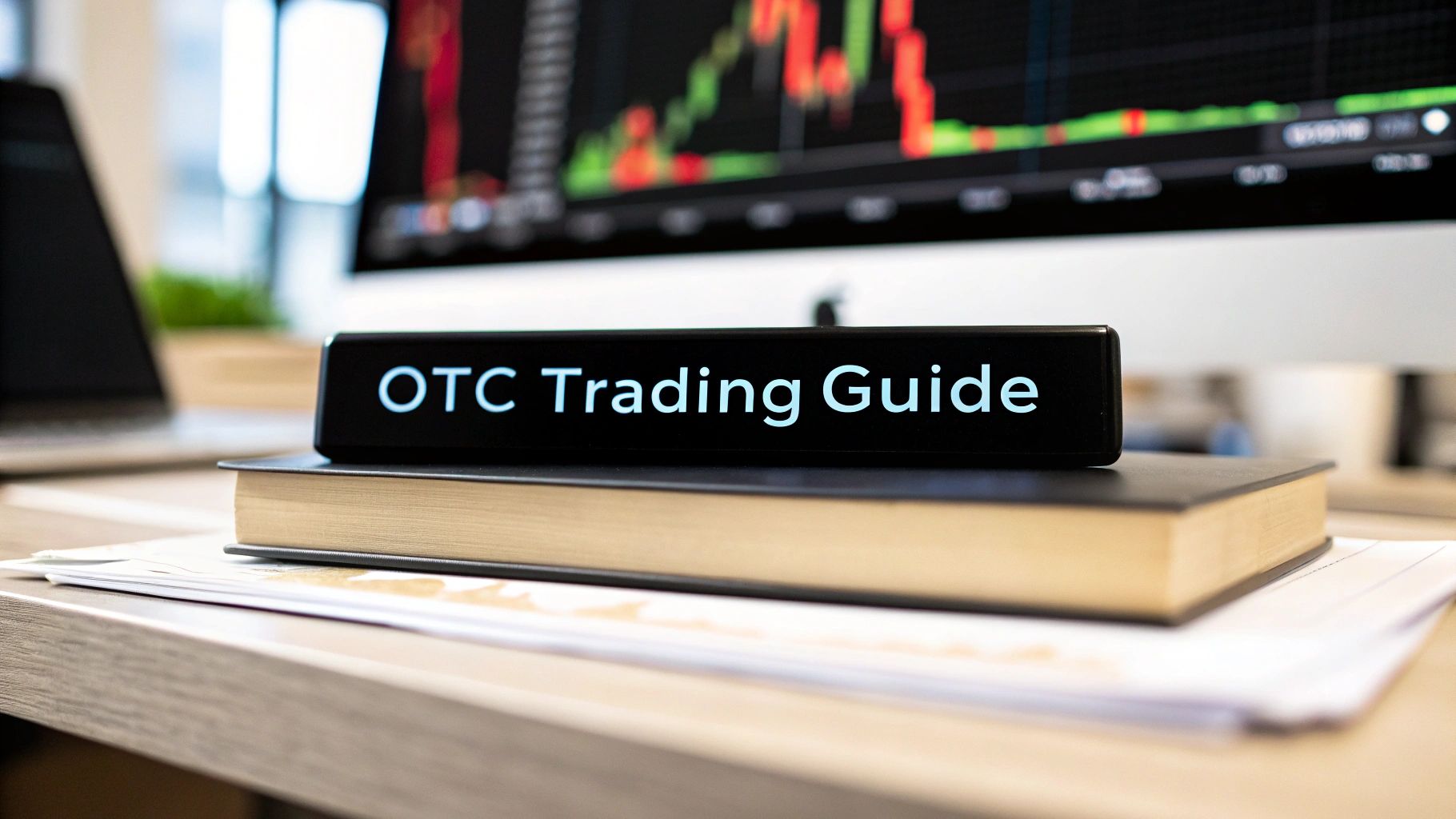An OTC trading platform isn't like the big stock exchanges you see on the news, like the NYSE or Nasdaq. Instead, think of it as a specialized marketplace where investors can trade securities directly with one another, sidestepping the central hub of a traditional exchange. It's more like a private, negotiated sale for financial assets than a public auction.
What Exactly Is an OTC Trading Platform?
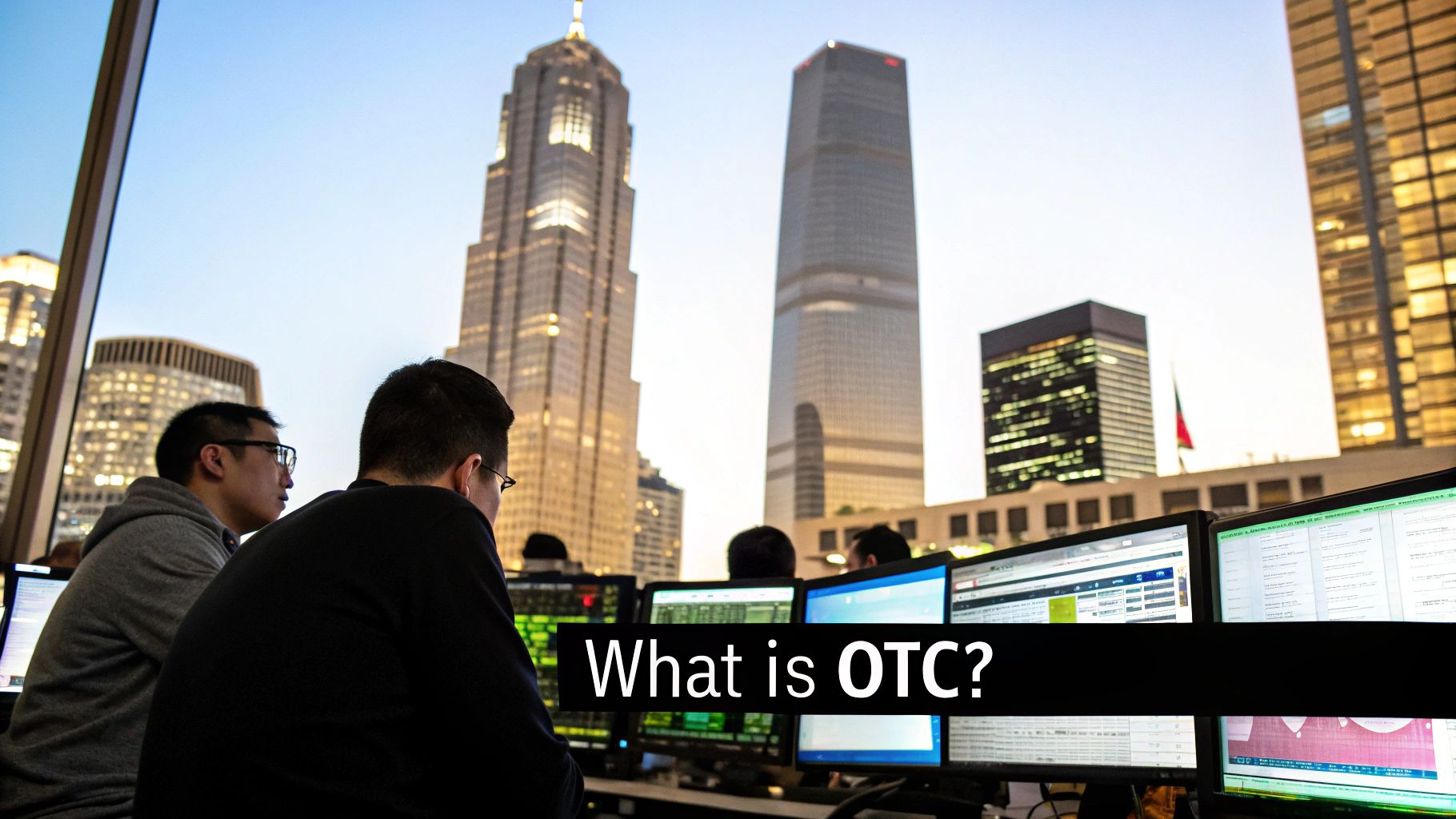
Let's use an analogy. Say you wanted to buy a rare, one-of-a-kind classic car. You probably wouldn't find it at a massive public auto auction. Instead, your best bet would be to connect with a specialized dealer or another collector to work out a price directly. An OTC (Over-the-Counter) trading platform works in a very similar way, but for financial securities.
These platforms build a network that lets buyers and sellers connect and transact without the rigid rules and structures of a formal exchange. They are absolutely vital for trading assets that can't, or don't, meet the strict listing requirements of the big players. This includes everything from the stocks of up-and-coming companies to various types of bonds and even custom-built financial instruments called derivatives.
The Decentralized Advantage
While an exchange is a centralized marketplace, an OTC platform powers a decentralized one. Trades happen across a network of broker-dealers who post their own "bid" and "ask" prices. This model offers some unique benefits:
- Negotiation Flexibility: Buyers and sellers can often negotiate prices and the size of the trade directly. This is a huge advantage for large "block trades" that might otherwise cause major price swings on a public market.
- Access to Unique Securities: OTC platforms open up a much wider world of investment opportunities. We're talking about thousands of international companies and smaller U.S. firms that you simply can't find anywhere else.
- More Flexible Hours: Traditional exchanges stick to a strict schedule. The OTC market, on the other hand, has a structure that allows for far more flexible trading sessions. To really make the most of global market movements, it’s crucial to understand the different OTC markets trading hours.
At its heart, an OTC platform provides the liquidity and price discovery needed for assets that would otherwise be nearly impossible to trade. It fills a critical gap in the wider financial world.
OTC Trading vs. Exchange Trading at a Glance
To really get a feel for how OTC platforms work, it helps to see them side-by-side with traditional exchanges. Both systems are for buying and selling securities, but their rules, methods, and overall feel are fundamentally different. The biggest contrasts are in how they're regulated, how transparent they are, and what you can trade on them.
This table breaks down the core differences, giving you a clear picture of what makes each marketplace unique.
| Feature | OTC Trading Platform | Traditional Stock Exchange |
|---|---|---|
| Structure | Decentralized network of dealers | Centralized, physical or electronic location |
| Regulation | Regulated by FINRA, less stringent disclosure | Heavily regulated by SEC, strict listing rules |
| Transparency | Price quotes from dealers; less public info | Real-time public bid/ask prices; high transparency |
| Securities | Unlisted stocks, bonds, derivatives, ADRs | Listed stocks, ETFs, options from major companies |
| Pricing | Negotiated between parties | Determined by auction-style supply and demand |
Ultimately, while exchanges offer a highly structured and transparent environment for well-known companies, OTC platforms provide essential access and flexibility for a vast, alternative universe of securities.
How a Typical OTC Trade Actually Works
If you’re used to the instant, anonymous clicks of a major stock exchange like the NYSE, an OTC trade feels completely different. Think of it less like an automated auction and more like a carefully negotiated business deal. It's a structured process involving key players, all connected through a network of broker-dealers. This setup is what allows securities that aren't publicly listed to be bought and sold efficiently.
Let’s say you want to buy a large block of shares in a promising international tech company that you can’t find on a major exchange. Your broker won't just punch an order into a massive, centralized system. Instead, they'll turn to an OTC trading platform to locate a market maker for that specific stock. This market maker is a firm that actually holds an inventory of the security, ready to either buy or sell.
The Key Players and Their Roles
For any OTC trade to happen, a few key participants need to communicate and work together. Each one plays a distinct part in making the market function.
- Investors: These are the buyers and sellers—the ones driving the action based on their investment goals.
- Broker-Dealers: Acting as the essential middlemen, they connect investors to the market, hunt down the best available price, and handle the transaction itself.
- Market Makers: These are the liquidity providers. They create the market for a stock by publishing their own prices to buy (bid) and sell (ask). The gap between these two prices is the bid-ask spread, which is how they earn their profit.
This simple infographic breaks down the three-step flow of a typical OTC trade.
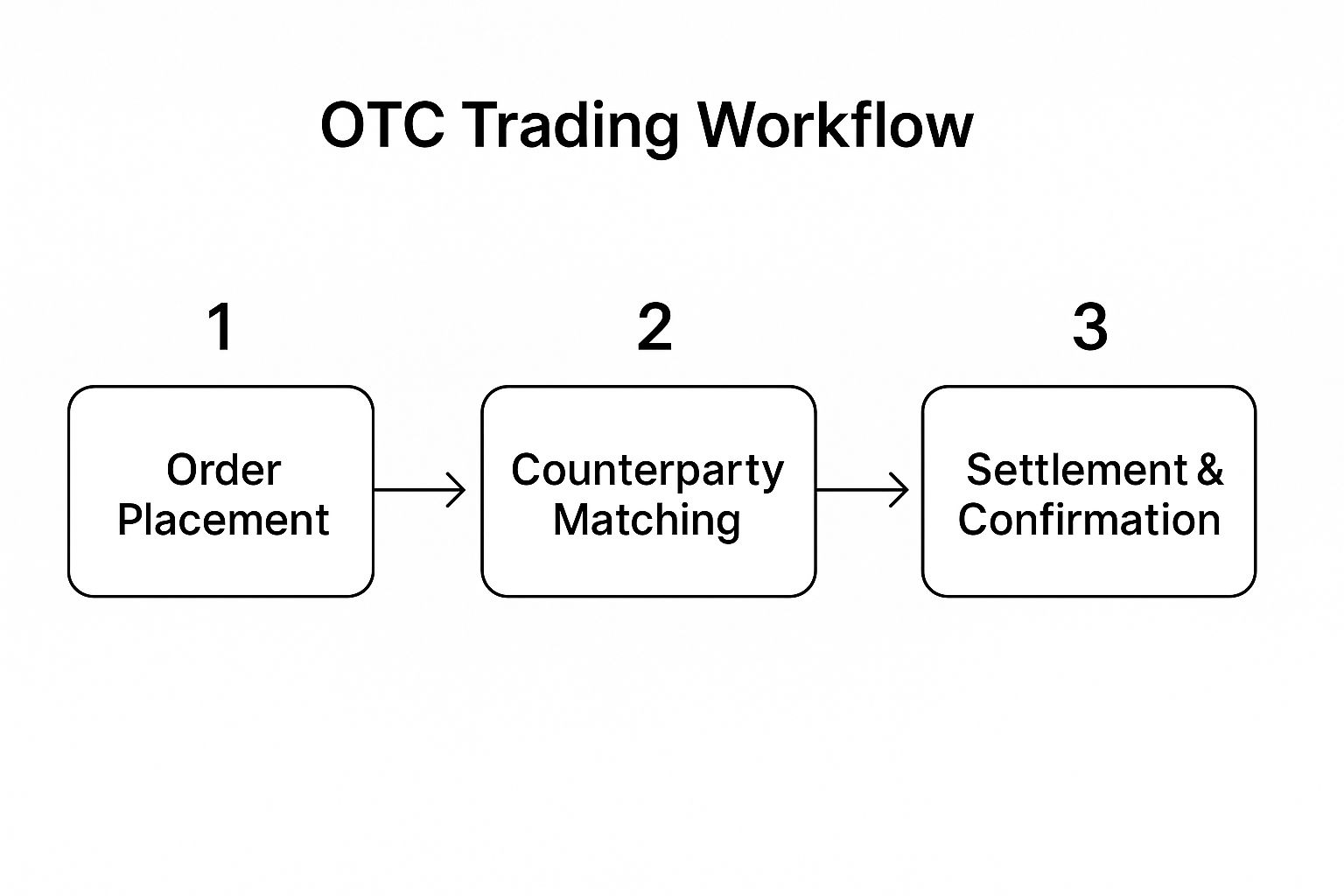
As you can see, the process moves logically from placing an order to finding a counterparty and finalizing the deal. It’s all about direct interaction, not a centralized auction system.
Understanding the OTC Market Tiers
It’s important to know that not all OTC securities are created equal. They're organized into different tiers based on how much information a company makes public. Getting familiar with these tiers is absolutely critical for sizing up risk before you invest.
A company's market tier is a direct reflection of its transparency. Higher tiers mean the company provides more reliable financial data, which generally translates to lower risk for you as an investor.
Here’s a quick rundown of the main tiers:
- OTCQX (The Best Market): This is the top shelf. Companies on OTCQX must meet high financial standards, keep their disclosures current, and be sponsored by a professional third-party advisor.
- OTCQB (The Venture Market): This is the middle ground, often home to entrepreneurial and growing companies. To be here, they must stay current with their reporting and pass an annual verification process.
- Pink (The Open Market): This tier has the loosest requirements. You'll find a wide mix of companies here, from legitimate firms that simply don’t disclose much to those in financial trouble. This is where you need to be the most careful.
By understanding this structure, you can navigate the diverse world of OTC stocks much more effectively and match your risk tolerance with the right opportunities.
The Real Reasons Traders Choose OTC Platforms
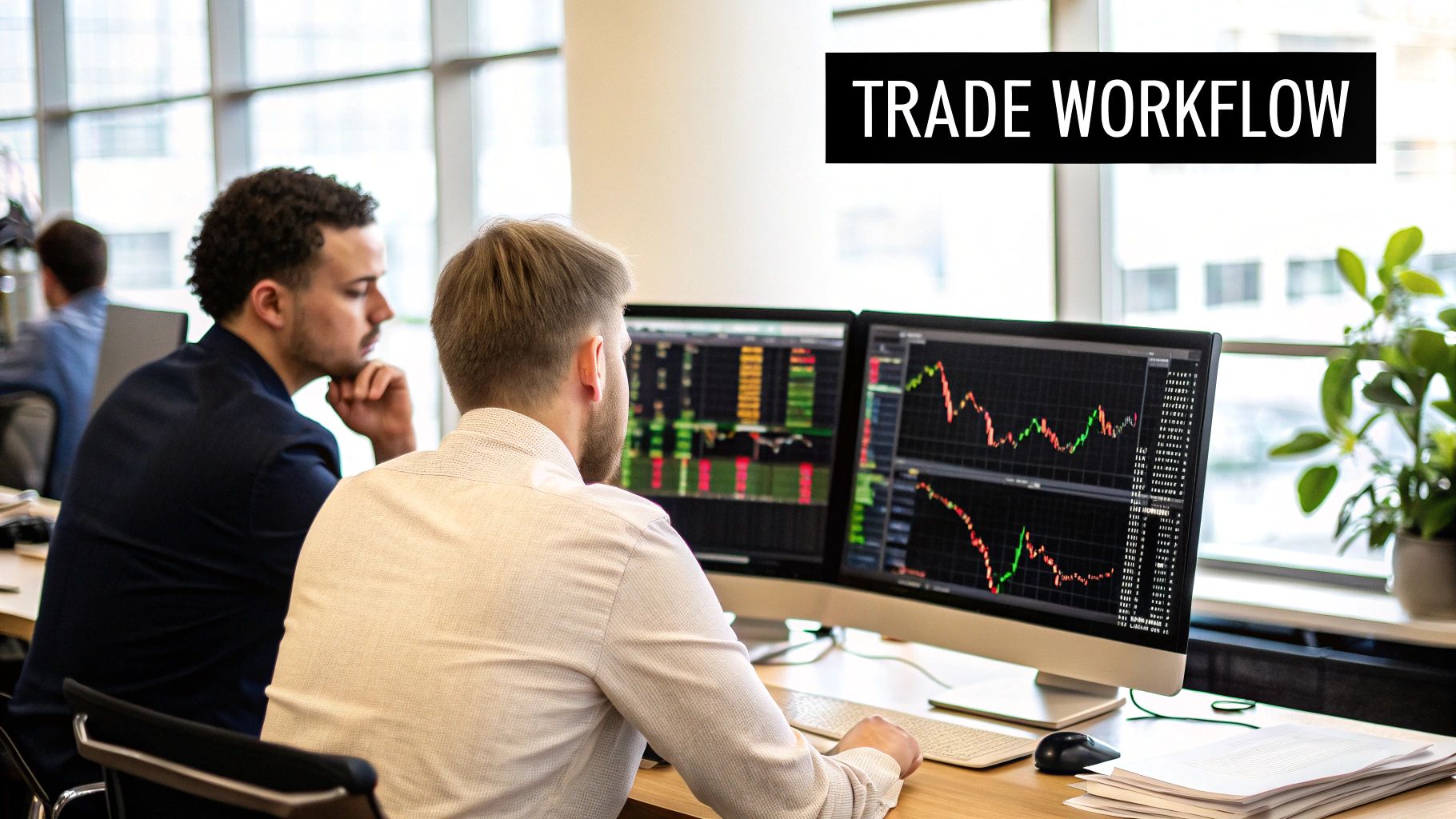
The buzz around OTC markets isn't just hype; it's a deliberate move by traders who see clear, tangible benefits. For many, the main attraction is gaining access to a whole universe of securities that you simply won't find on major exchanges like the NYSE or Nasdaq.
Think of it this way: an OTC trading platform is your key to a massive, unlisted catalog of opportunities. It opens the door to investing in up-and-coming companies with serious growth potential, established global brands, and niche financial instruments. This provides a level of portfolio diversification that is impossible to achieve through traditional channels alone.
The Power of Flexibility and Negotiation
Beyond the sheer volume of securities available, the very structure of OTC trading offers a degree of flexibility that centralized exchanges can't hope to match. You’re not just a passive price-taker in a high-speed, anonymous auction. Instead, you often have the ability to negotiate directly on both the price and the size of your trade.
This is a game-changer for large institutional investors looking to execute massive "block trades." Dropping a huge order onto a public exchange can send prices swinging wildly, creating chaos. The negotiated, person-to-person nature of an OTC transaction helps smooth out that impact, leading to much more predictable execution. It puts a human touch back into the deal-making process, focusing on finding a price that works for everyone involved.
A Market Reshaped by Demand
The shift toward OTC platforms is fueled by powerful market dynamics. There's a growing appetite for unique investment stories—companies that might be too small, too new, or too specialized to bother with a major exchange listing. For a closer look at this landscape, our guide on trading OTC markets dives into the specifics.
This isn't just anecdotal, either. The numbers tell a powerful story.
Between 2017 and 2020, transaction growth on OTC platforms shot up by an astonishing 93.2 percentage points. For comparison, traditional exchanges grew by just 13.0 percentage points in the same period. This surge pushed the overall share of OTC trading from 9.9% to 15.8% of all transactions, proving it's a significant and expanding part of the financial world. You can dig into the complete dataset in this SIFMA Insights report.
At the end of the day, the reasons traders flock to OTC platforms come down to three key advantages: expanded access to unique securities, greater flexibility in how they trade, and the opportunity to tap into a vibrant, growing market.
These factors together build a convincing argument for why so many traders are looking beyond the usual suspects to find their next big opportunity.
What to Look for in a Modern OTC Platform
Picking the right OTC trading platform can feel like a maze, but it really comes down to a few core features you can't do without. Before you commit, it helps to have a mental checklist. This isn't about flashy marketing—it’s about finding the essential tools that give you a real edge in the over-the-counter market.
First up, the quoting system is everything. Unlike a big exchange where there's one official price, the OTC market is a network of market makers. A good platform pulls all their quotes together in one place, so you can instantly see the best bid and ask prices. Trading without this is like flying blind.
Just as critical are the trade execution tools. You need a platform that executes your trades quickly, reliably, and at the price you expect. There’s nothing worse than getting a different price than you clicked on because of delays or "slippage." Look for platforms that give you instant trade confirmations and a straightforward way to manage your open orders.
The Core Functionality Checklist
To make a smart choice, any modern OTC platform needs to nail a few fundamentals. Think of these as the foundation for a secure and effective trading setup, giving you the control and information you need to make decisive moves.
- Deep Market Data Access: You need more than just a price. A solid platform will offer historical price charts, trading volumes, and direct access to company filings. This is especially crucial for researching the less-transparent stocks on the Pink sheets.
- Robust Security Protocols: You're trusting the platform with your money, so security is non-negotiable. Look for basics like two-factor authentication (2FA) and data encryption, but also check for clear policies on how your assets are held. Security isn't a feature; it's a requirement.
- Intuitive User Interface (UI): Trading is complicated enough without having to fight with the software. A clean, well-designed interface flattens the learning curve and, more importantly, helps you avoid costly mistakes when placing orders.
The goal is to find an OTC trading platform that turns a flood of market data into clear, actionable insights. When the right features come together, you have the power to spot trends, manage your risk, and execute your strategy with confidence.
Advanced Capabilities That Make a Difference
Once the basics are covered, a few advanced features can seriously upgrade your trading game. One of the biggest is around-the-clock market access.
The rise of overnight trading sessions, like those powered by MOON ATS, means you can react to international news or earnings reports as they break, not hours later. Platforms that offer 24/7 or extended-hours trading give you a clear strategic advantage.
Finally, think about how the platform plays with other tools. The ability to connect with powerful charting software, like the industry-standard MetaTrader 4 (MT4), is a game-changer. This integration creates a seamless and powerful workflow, letting you perform much deeper analysis before making a decision.
How Technology Is Reshaping OTC Trading
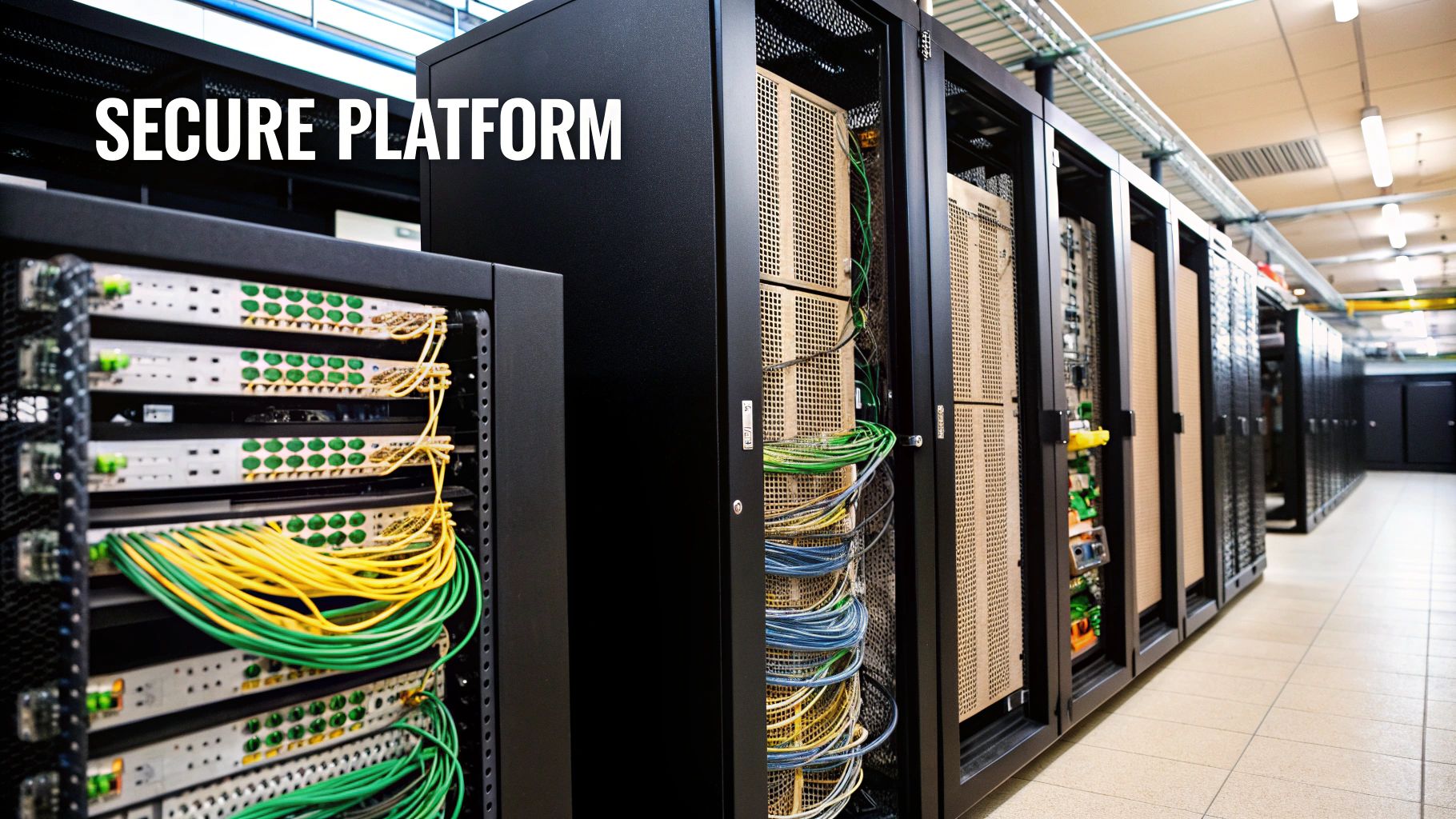
The image of over-the-counter trading as a world of frantic phone calls and handshake deals is a relic of the past. Today, the OTC trading platform has become a sophisticated digital hub, injecting a level of precision and speed into the market that was once pure science fiction. This isn't just a minor update; it's a fundamental change in how traders engage with these unique securities.
The biggest driver of this change? Automation. Modern platforms are powered by smart algorithms that take over tasks once bogged down by human effort. These systems can scan the market for opportunities, flag price movements, and execute trades based on your predefined rules—all with breathtaking accuracy.
This technological leap has opened up the market in incredible ways. Instead of being limited to a small network of dealers, traders can now access real-time quotes from numerous sources. The result is a far more competitive and transparent pricing environment for everyone involved.
The Power of Algorithmic Efficiency
Algorithmic trading is more than just raw speed; it's about executing trades intelligently. These systems excel at minimizing market impact, a crucial factor when dealing with large orders. For example, an algorithm can slice a huge trade into smaller, bite-sized pieces, feeding them into the market strategically over time to avoid spooking prices.
The impact is impossible to ignore. The move toward automation allows traders to handle even smaller transactions with maximum efficiency. Look at Tradeweb, a major player in this space. The share of European Union trades handled by its AiEX automated system soared from 50% to 66% between 2020 and 2022, driven by a 22% jump in client adoption. You can dig deeper into this trend with this detailed industry analysis.
Unified Control Over Diverse Assets
Another huge step forward is the ability to manage a whole spectrum of asset classes from one dashboard. A modern OTC trading platform can bring your entire portfolio—from fixed-income and complex derivatives to global equities—under a single, unified view.
This integration is a massive advantage for both strategy and risk management. It gives traders the power to:
- See the whole board: Analyze how different assets in their portfolio influence each other.
- Execute complex plays: Move capital seamlessly between different OTC products to capitalize on opportunities.
- Manage risk holistically: Keep a constant, real-time pulse on their total market exposure.
By combining powerful automation with a consolidated view of diverse assets, today’s technology has turned the OTC trading platform from a simple communication tool into a high-powered command center for financial strategy.
This evolution has made OTC markets more accessible, efficient, and dynamic than ever before.
Using OTC Charts MT4 to Gain a Competitive Edge
It’s one thing to understand the theory behind an OTC trading platform, but it’s another to actually use that knowledge to get ahead. This is precisely where a specialized tool like OTC Charts MT4 comes in, turning abstract market ideas into real, actionable trading signals.
Think of it this way: OTC Charts MT4 was built from the ground up to solve the exact challenges we've been talking about.
Instead of hunting for reliable information across a dozen different sources, the tool pipes a direct, real-time feed of OTC quotes from Pocket Option straight into the familiar interface of MetaTrader 4 (MT4). This integration is everything. You're not just passively watching data; you're actively analyzing it inside a professional-grade platform celebrated for its powerful charting and analysis tools. It's like dropping a modern, high-performance engine into the chassis of a trusted, classic car—you get proven reliability supercharged with cutting-edge power.
From Complex Data to Clear Decisions
The real magic of OTC Charts MT4 is how it cuts through the noise. In the OTC world, where information can feel scattered and inconsistent, having a clear, trustworthy chart isn't just a nice-to-have, it's an absolute must.
Here’s how it makes that happen:
- Seamless MT4 Integration: Because it works right inside MetaTrader 4, you can use all the technical indicators, trend lines, and drawing tools you already know and love on live OTC data.
- Real-Time Quote Delivery: It gets rid of the frustrating lag and guesswork common in OTC markets by streaming quotes directly from the source. This means you’re reacting to the market as it moves, not ten seconds after the fact.
The bottom line is this: OTC Charts MT4 brings clarity to a market that is often murky. By serving up precise data within a powerful analytical framework, it helps you shift from guessing to executing trades with genuine confidence.
Capitalizing on Every Market Opportunity
One of the biggest draws of OTC trading is that the market doesn't sleep. It’s open on weekends and after-hours when traditional exchanges are dark. This is where having the right otc trading platform tool becomes a game-changer.
OTC Charts MT4 offers uninterrupted, 24/7 chart access. You'll never miss an opportunity just because it's Saturday. You can analyze weekend price action to get a head start on the week or react instantly to major global news as it breaks.
This constant access, paired with a full suite of professional MT4 charting tools, gives you a serious advantage. When you have a tool designed specifically for the unique rhythm of the OTC market, you’re simply in a better position to spot trends, manage your risk, and make smarter decisions every single time you trade.
Answering Your Top OTC Trading Questions
Jumping into over-the-counter markets naturally brings up a few questions. It’s a different world from the big exchanges, so it pays to get some clear answers before you start. Let's walk through some of the most common things traders ask.
Is It Safe to Trade on an OTC Platform?
This is probably the most important question, and the answer has two sides. First, the platform itself. Reputable OTC trading platforms are built with strong security, like data encryption, to keep your account and personal information locked down.
The second part is about the investments themselves. This is where the risk can creep in. Many companies on OTC markets aren't required to disclose as much information as those on, say, the NYSE. This is where your own homework becomes your best defense. Diligently researching every security is non-negotiable. Pay close attention to its market tier—an OTCQX company, for example, has much stricter reporting rules than a Pink market company, which often means it's a less risky bet.
What Kinds of Companies Trade on OTC Markets?
The diversity is one of the most exciting things about OTC markets. You'll find a whole spectrum of businesses here.
- Small and Developing Companies: Think of it as a launchpad for up-and-coming businesses, both from the U.S. and abroad, that don't yet meet the strict listing requirements of major exchanges.
- Big International Names: You can often find American Depositary Receipts (ADRs) for well-known global brands, giving you a straightforward way to invest in them.
- Other Financial Instruments: It's not just stocks. The OTC space is also home to certain bonds, derivatives, and other specialized securities that you simply won't find on a standard public exchange.
How Is OTC Trading Different for a Retail Investor?
For the average retail investor, the biggest differences boil down to information and liquidity. OTC stocks often have a wider gap between the buying and selling price (the bid-ask spread), which can make your trades a bit more expensive. You'll also find that you have to dig a little deeper to find company information.
This really puts the ball in your court when it comes to research. But with that extra effort comes a massive upside: you get access to thousands of unique investment opportunities that are completely off-limits on the traditional exchanges.
Ready to put this knowledge to work? OTC Charts MT4 provides the professional-grade tools you need to analyze the OTC market with total clarity. Gain a real competitive advantage with live data and smooth MetaTrader 4 integration by visiting the official OTC Charts MT4 website.


